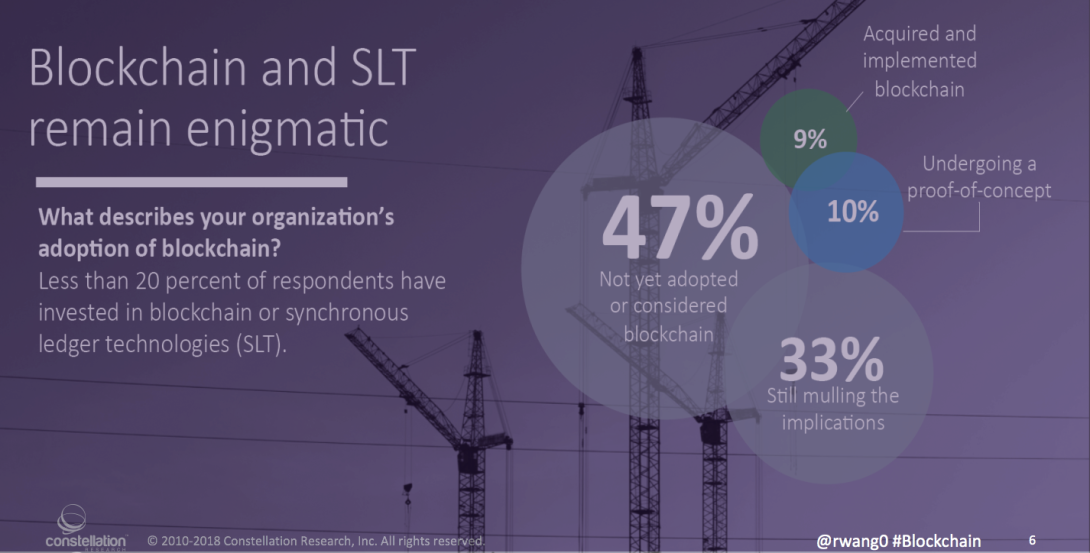
Best Practices: Seven Steps To Success In Enterprise Blockchain
Enterprise Adoption of Blockchain Nascent For Now, But Rapidly Growing
Recent Constellation Research surveys from Q4 2017 show that less than 20% of our market leading and fast follower clients have either acquired and implemented blockchain or undergoing a proof of concept (see Figure 1). One-third of survey respondents still mull the implications as they consider POC's. Meanwhile, 47% have not yet adopted or considered blockchain in their portfolio of exponential technologies. Three reasons for low adoption include
- Rapidly evolving platforms and standards. Blockchain remains a wild west as a plethora of platforms come and go. The ten most popular platforms and standards include Bigchain DB, Chain Core, Ethereum, Hyperledger Fabric, IOTA, LISK, OpenChain, R3 Corda, Ripple, and Quorum. Each platform has significant benefits and trade offs as they evolve to meet enterprise requirements. Most organizations have started on one platform and evolved into another.
- Current performance barriers. Transaction performance of the blockchain remains a valid concern. Today Bitcoin can barely move beyond seven transactions per second (TPS). Across the board, overall transaction times remain slow with Ethereum at 20 TPS, IBM Blockchain at 1000 TPS, and Ripple at 1500 TPS. To put this in perspective, Visa payments does about 1700 TPS and Alibaba does about 325,000 TPS.
- Lack of internal and external expertise. Most organizations have not been able to find significant blockchain technical resources let alone the business resources to craft new business models. The plethora of platforms and standards adds to the scarcity of resources. Today's resources have often risen from internal reskilling and training programs.
Figure 1. Most Organizations Still Not Ready For Enterprise Adoption Of Blockchain

The Bottom Line: Take Seven Steps To Enterprise Blockchain Success
Lessons learned from market leaders and fast followers show key design points for success (see Figure 2). Almost every early adopter has built on multiple platforms and have learned from their mistakes. Here are seven design points to craft a proper blockchain strategy:
- Choose a platform. Understand the trade offs on existing platforms. Some platforms have better performance metrics. Other platforms support complex value exchange and smart contracts. Some platforms do better with value exchange. Every platform has its limitations.
- Start experimenting. The market has rapidly evolved. Organizations who start early build out support networks and develop informal relationships which help with resolving implementation issues and recruiting talent. Staying current on the technology enables agility as the technology rapidly evolves.
- Get security and scalability right. Security remains paramount on blockchain. Enterprises accustomed to centralized models must make a shift to decentralized approaches. Security requirements must combat system gaming, 51% consensus attacks, and smart contract bugs. Design will require that assets and securitization occur on the same token. Meanwhile, scalability remains limited to a sub 2000 TPS for most platforms. As the number of node increase, the scalability requirements will also geometrically increase.
- Build a legal framework for engagement. Blockchain's decentralized premise often dis-intermediates existing legal frameworks and bypass global standards. Legal guidance should be brought in early to derisk potential legislative and regulatory environments.
- Set up smart contracts. Smart contracts use computer code to set the terms and conditions for engaging with other parties without a middleman. As the heart of many blockchain business models, these smart contracts provide not only a framework for rules governing a transaction, but also provides a computer program to enforce the rules.
- Understand value exchange and gamification. Value exchange and gamification provide the incentives to create a marketplace. Value exchange models often include monetary, non monetary, and consensus. Blockchain business models create gamified approaches to influence certain behaviors.
- Model out the network ecosystems. Blockchain business models ultimately must reflect new economic models. Consequently, design of these new business models must determine how the entire ecosystem will engage and interact in a community of self-interest. In fact the value of these new business models will come from the insights derived from the network interactions.
Figure 2. Seven Design Points To Create An Enterprise Blockchain Strategy

The Bottom Line: Get Started Now
Digital Darwinism is unkind to those who wait. Constellation expects early adopter organizations to leap frog ahead of existing competitors who do not rethink business models and apply blockchain as an exponential technology in their overall portfolios. Those organizations who wait will notice the significant gaps among early adopters.
Your POV.
Ready to roll out your plans for digital transformation. Do you understand the business model implications? Are you ready to disrupt the board and jump start growth? Add your comments to the blog or reach me via email: R (at) ConstellationR (dot) com or R (at) SoftwareInsider (dot) org.
- Developing your digital business strategy
- Connecting with other pioneers
- Sharing best practices
- Vendor selection
- Implementation partner selection
- Providing contract negotiations and software licensing support
- Demystifying software licensing
Reprints can be purchased through Constellation Research, Inc. To request official reprints in PDF format, please contact Sales .
Resources And Related Research
Monday’s Musings: Designing Five Pillars For Level 1 Artificial Intelligence Ethics March 26, 2018
Research Report: Constellation’s Futurist Framework (PESTEL) – The Societal Outlook Pre @Davos #WEF18 January 18, 2018
Research Report: Constellation’s Futurist Framework (PESTEL) – The Economic Outlook Pre @Davos #WEF18 January 17, 2018
Research Report: Constellation’s Futurist Framework (PESTEL) – The Political Outlook Pre @Davos #WEF18 January 16, 2018
Monday’s Musings: Want AI Ethics? Learn From These Four Movies/TV Shows!December 3, 2017
Research Report: Demystifying Artificial IntelligenceNovember 16, 2017
Monday’s Musing: Infinite Ambient Orchestration November 6, 2017
Tuesday’s Tip: Know When To Automate With Artificial Intelligence September 19, 2017
Personal Log: Congratulations To Constellation’s BT-150 Winners #BT150 September 6, 2017
Research Summary: Constellation ShortList™ Integration Platform as a Service (IPaaS) August 13, 2017
Research Summary: Constellation ShortList™ Synchronous Ledger and Blockchain Platforms August 13, 2017
Research Summary: The Future of Customer Experience (CX) is Orchestrated Engagement June 15, 2017
Research Summary: Nine Starting Points For Digital Transformation In Manufacturing May 10, 2017
Research Summary: Artificial Intelligence Delivers Mass Personalization In Commerce April 17, 2017
Tuesday’s Tip: Seven Universal Factors Why Technology Firms Fail January 10, 2017
Monday’s Musings: Dynamic Leadership – A Responsive And Responsible Approach #Davos17 #WEF
News Analysis: In Search Of Growth Amidst Digital Disruption
Event Report: The Weekend Before Davos And The Dawn Of The Fourth Industrial Revolution
Event Report: The Future Of Jobs From #Davos16 #WEF
Event Report: The Transformation of Finance #Davos16 #WEF
Event Report: A New Platform For The Digital Economy #Davos16 #WEF
Monday’s Musings: Secrets Behind Building Any AI Driven Smart Service November 28, 2016
Trends: Five Data Center Trends For 2017 November 12, 2016
News Analysis: America In An @RealDonaldTrump Era – Everything International Clients Need To Know PESTEL Part 1. November 10, 2016
Research Summary: Constellation’s AstroChart For Business Trends, Q4 2016 October 18, 2016
Research Summary: Constellation’s AstroChart For Tech Trends October 17, 2016
Monday’s Musings: Secrets Behind Building Any AI Driven Smart Service
Monday’s Musings: Understand The Spectrum Of Seven Artificial Intelligence Outcomes
Tuesday’s Tip: Seven Factors For Precision Decisions In Artificial Intelligence
Monday’s Musings: Data – The Foundation Of Real-Time Digital Business
‘Monday’s Musings: Who Gets To Be A Chief Digital Officer?
Monday’s Musings: CXOs Seek Enterprise-Grade Mobile Solutions Despite Seven Barriers August 16, 2016
Research Summary: [VIDEO] Inside Constellation’s Futurist Framework August 9, 2016
Best Practices: Five Critical Success Factors To Digital Transformation July 10, 2016
Monday’s Musings: Data – The Foundation Of Real-Time Digital Business May 23, 2016
Monday’s Musings: Why Digital Transformation Must Move Beyond The Hiring Of A Chief Digital Officer April 25, 2016
Monday’s Musings: The Four Personas Of The Modern CMO In A Digital World April 11, 2016
Monday’s Musings: The Seven Rules For Digital Business And Digital Transformation
Tuesday’s Tip: Five Steps To Starting Your Digital Transformation Initiative
Research Summary: Economic Trends Exacerbate Digital Business Disruption And Digital Transformation (The Futurist Framework Part 3)
Research Summary: Five Societal Shifts Showcase The Digital Divide Ahead (The Futurist Framework Part 2)
Research Summary: Sneak Peaks From Constellation’s Futurist Framework And 2014 Outlook On Digital Disruption
Research Report: Digital ARTISANs – The Seven Building Blocks Behind Building A Digital Business DNA
Research Summary: Five Societal Shifts Showcase The Digital Divide Ahead (The Futurist Framework Part 2)
Research Summary: Next Generation CIOs Aspire To Focus More On Innovation And The Chief Digital Officer Role
Trends: [VIDEO] The Digital Business Disruption Ahead Preview – NASSCOM India Leadership Forum (#NASSCOM_ILF)
Harvard Business Review: What a Big Data Business Model Looks Like
Monday’s Musings: How The Five Consumer Tech Macro Pillars Influence Enterprise Software Innovation
Tuesday’s Tip: Understand The Five Generation Of Digital Workers And Customers
Monday’s Musings: The Chief Digital Officer In The Age Of Digital Business
Slide Share: The CMO vs CIO – Pathways To Collaboration
Research Summary And Speaker Notes: The Identity Manifesto – Why Identity Is At The Heart of Digital Business
Disclosure
Although we work closely with many mega software vendors, we want you to trust us. For the full disclosure policy,stay tuned for the full client list on the Constellation Research website. * Not responsible for any factual errors or omissions. However, happy to correct any errors upon email receipt.
Copyright © 2001 – 2018 R Wang and Insider Associates, LLC All rights reserved.
Contact the Sales team to purchase this report on a a la carte basis or join the Constellation Executive Network
 R "Ray" Wang
R "Ray" Wang R "Ray" Wang
R "Ray" Wang